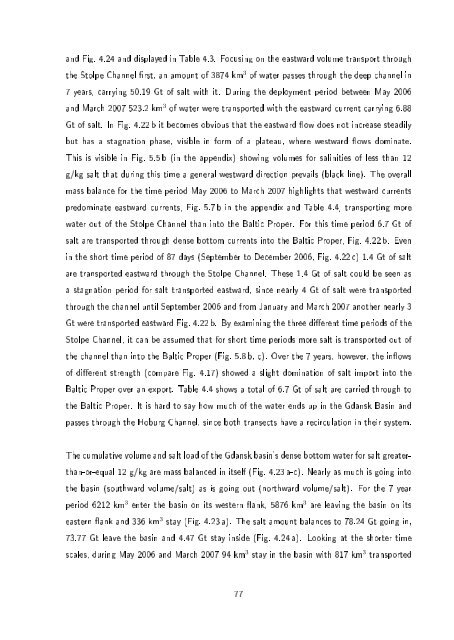Baltic Sea
Baltic Sea
Baltic Sea
You also want an ePaper? Increase the reach of your titles
YUMPU automatically turns print PDFs into web optimized ePapers that Google loves.
and Fig. 4.24 and displayed in Table 4.3. Focusing on the eastward volume transport through<br />
the Stolpe Channel rst, an amount of 3874 km 3 of water passes through the deep channel in<br />
7 years, carrying 50.19 Gt of salt with it. During the deployment period between May 2006<br />
and March 2007 523.2 km 3 of water were transported with the eastward current carrying 6.88<br />
Gt of salt. In Fig. 4.22 b it becomes obvious that the eastward ow does not increase steadily<br />
but has a stagnation phase, visible in form of a plateau, where westward ows dominate.<br />
This is visible in Fig. 5.5 b (in the appendix) showing volumes for salinities of less than 12<br />
g/kg salt that during this time a general westward direction prevails (black line). The overall<br />
mass balance for the time period May 2006 to March 2007 highlights that westward currents<br />
predominate eastward currents, Fig. 5.7 b in the appendix and Table 4.4, transporting more<br />
water out of the Stolpe Channel than into the <strong>Baltic</strong> Proper. For this time period 6.7 Gt of<br />
salt are transported through dense bottom currents into the <strong>Baltic</strong> Proper, Fig. 4.22 b. Even<br />
in the short time period of 87 days (September to December 2006, Fig. 4.22 c) 1.4 Gt of salt<br />
are transported eastward through the Stolpe Channel. These 1.4 Gt of salt could be seen as<br />
a stagnation period for salt transported eastward, since nearly 4 Gt of salt were transported<br />
through the channel until September 2006 and from January and March 2007 another nearly 3<br />
Gt were transported eastward Fig. 4.22 b. By examining the three dierent time periods of the<br />
Stolpe Channel, it can be assumed that for short time periods more salt is transported out of<br />
the channel than into the <strong>Baltic</strong> Proper (Fig. 5.8 b, c). Over the 7 years, however, the inows<br />
of dierent strength (compare Fig. 4.17) showed a slight domination of salt import into the<br />
<strong>Baltic</strong> Proper over an export. Table 4.4 shows a total of 6.7 Gt of salt are carried through to<br />
the <strong>Baltic</strong> Proper. It is hard to say how much of the water ends up in the Gdansk Basin and<br />
passes through the Hoburg Channel, since both transects have a recirculation in their system.<br />
The cumulative volume and salt load of the Gdansk basin's dense bottom water for salt greaterthan-or-equal<br />
12 g/kg are mass balanced in itself (Fig. 4.23 a-c). Nearly as much is going into<br />
the basin (southward volume/salt) as is going out (northward volume/salt). For the 7 year<br />
period 6212 km 3 enter the basin on its western ank, 5876 km 3 are leaving the basin on its<br />
eastern ank and 336 km 3 stay (Fig. 4.23 a). The salt amount balances to 78.24 Gt going in,<br />
73.77 Gt leave the basin and 4.47 Gt stay inside (Fig. 4.24 a). Looking at the shorter time<br />
scales, during May 2006 and March 2007 94 km 3 stay in the basin with 817 km 3 transported<br />
77



